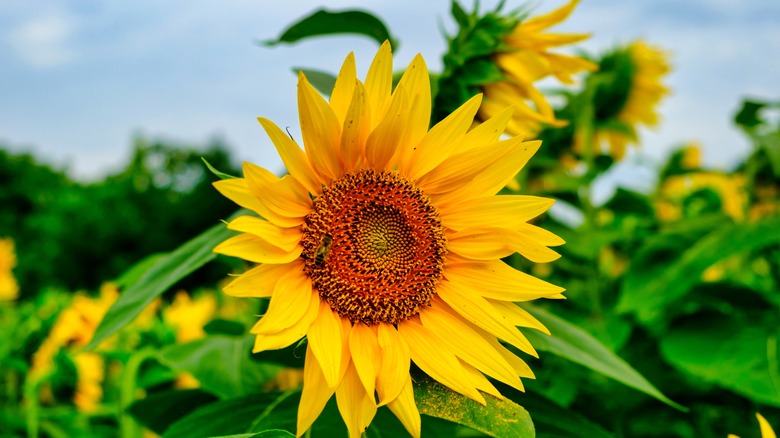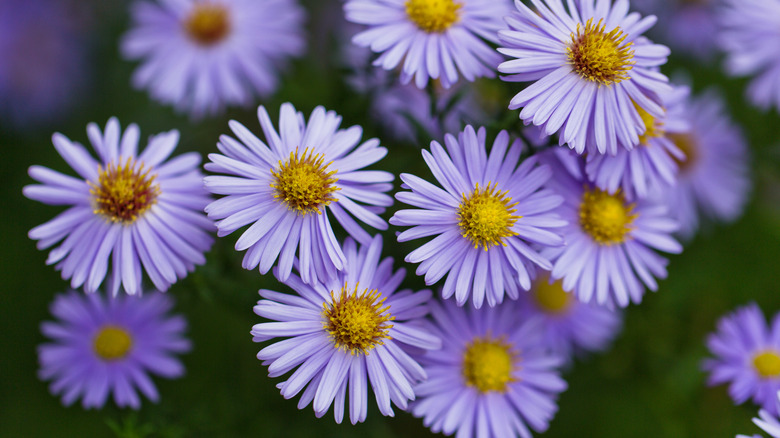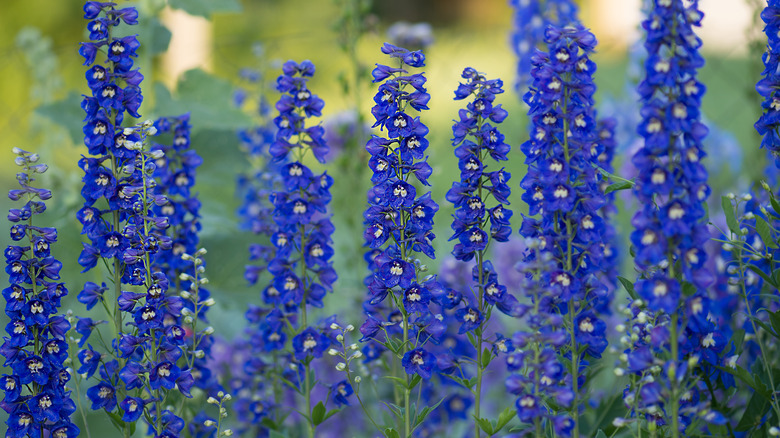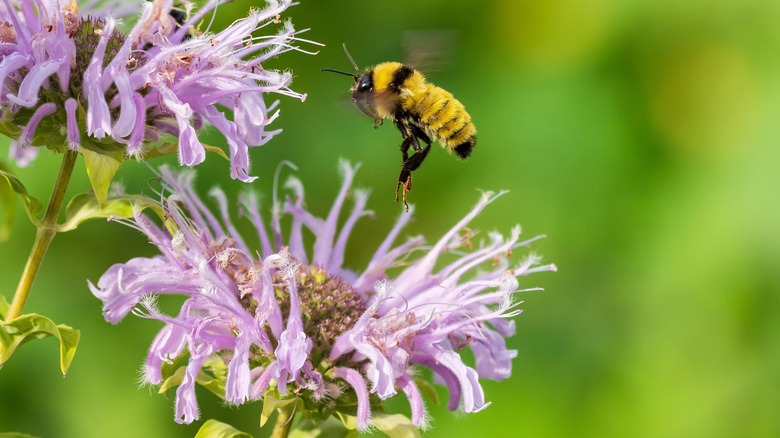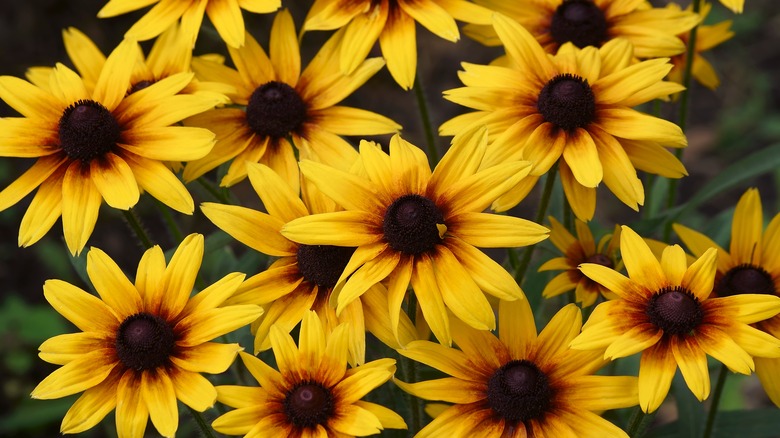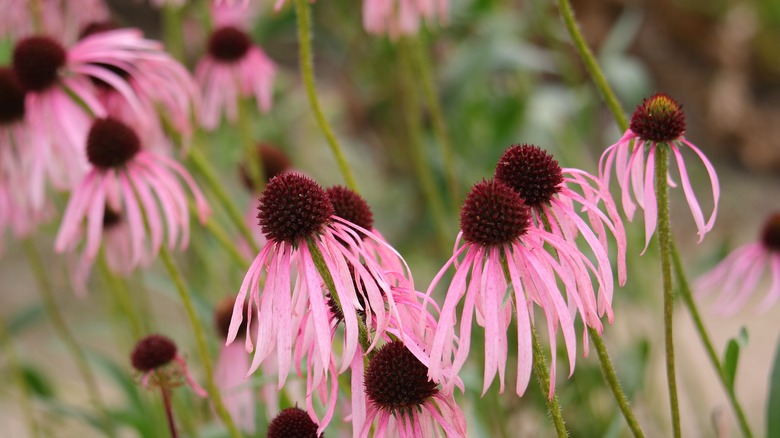15 Colorful Flowers That Will Bring Bees Into Your Yard
It's no secret that bees make the world go round. The diligent honey bee is responsible for every one of three bites we eat, according to the U.S. Department of Agriculture. There are more than 20,000 species of bees, and 4,000 of them are native to the U.S., per the USGS; however, as climate change and deforestation impact bees' survival, these talented insects are endangered. Because they impact food production and support the habitats of wildlife, it's essential that we do our part to help them survive. Your own backyard garden, windowsill flower box, or even front porch flower pot can help these pollinators.
We'll walk you through 15 colorful flowers that you can plant to help bees. But first, there are a few guidelines to mind when you're trying to create a bee-friendly garden. First, try to use native plants to your region, as the bees there have evolved with these species, and these plants are engineered to thrive in your yard. Don't just look for flowers that blossom in peak season; try to fill your garden, no matter its size, with early- and late-blooming plants. If you aren't sure what is best for your yard, look for a guide specific to your state or climate region.
1. Sweet alyssum
Sweet alyssum (Lobularia maritima) is an herbaceous perennial that blossoms from April to June, per Texas Master Gardener. These are hearty flowers that can tolerate both drought and cold. Their flowers come in purple, white, and pink varieties — all shades bees just can't get enough of. And they don't call it sweet for nothing! Alyssum, sometimes known as sweet alison, has a sweeping pleasant fragrance that bees are extremely enticed by. Alyssum thrives in USDA hardiness zones 5-9, with partial or complete sun exposure, and in moist but well-draining soil, growing up to 10 inches high.
2. Sunflower
The sunflower (Helianthus annuus) is characterized by its brilliant buttery yellow petals and its enticing seed-growing centers. These lemony flowers are a favorite of bees because they can provide both nectar and pollen, the latter of which bees use to feed their young, says Carolina Honeybees. Be sure to avoid pollenless varieties, as these have no benefit to bees. The flower's seeds can also serve as food for other wildlife. The sunflower does well in well-draining soil with full exposure to sunlight, thrives in the USDA zones 2-11, and can grow between 3 and 10 feet tall.
3. Cosmos
You don't have to look up to see a cosmos — cosmos plants (Cosmos bipinnatus) are gorgeous flowers that bees can't get enough of. If you're specifically targeting bees, look for varieties in pink, white, yellow, and purple. Arrange them in your garden as you please; they will bloom beautifully all summer long and through the fall. Cosmos do best in well-draining neutral soil with full sun exposure, Almanac says, and grow well in USDA hardiness zones 2-11, reaching from 1 to 6 feet tall.
4. Lavender
Part of the mint family, lavender flowers (Lavendula spp.) are beloved for their soothing purple shade, medicinal, and cleaning purposes. But they're also great for attracting bees thanks to their vibrant colors, far-reaching scent, and because they flower in early spring, says Gardenia. Their blooming period is especially vital to bee populations because many bee-friendly plants don't flower until summer and even fall. This fills an important slot in the growth gap. Lavender can grow as tall as 2 to 4 feet, needs full sun exposure, alkaline dry soil, and is in the USDA 5a-9a hardiness zones.
5. Aster
Asters (Symphyotrichum spp.), sometimes known as New England asters or frost flowers, bloom in the late summer and fall, a time when many bee food sources have already disappeared, according to Garden Design, making them a fantastic addition to a year-round bee-friendly garden. They are available in pink, purple, and blue hues. Aster flowers are also a late-season favorite of nectar-hungry butterflies. These daisy-like flowers grow in zones 3-8 and thrive in neutral-acidic loamy, well-draining soil, and full sun exposure. They can reach up to 4 feet in height.
6. Delphinium
Though at first glance, you may confuse delphinium (Delphinium elatum) with lavender, these stunning flower sprigs are actually part of the Ranunculaceae family. There are over 400 species of delphinium, per Swansons Nursery. Perennial, annual, and biennial varieties are available and are good for long-tongued bees and hummingbirds. However, remember that these are toxic to humans and animals, so do not plant them where they might be consumed by accident. They bloom in early to late summer, require neutral to alkaline soil, grow up to 6 feet tall, and need full sun exposure in USDA zones 3-7.
7. Lantana
Think of the lantana (Lantana camara) as a bang for your buck bee-friendly blossom. This shrub flower grows in vibrant, colorful clusters, ranging in hues from yellow to pink, purple, orange, and even red. While bees are mostly drawn to the blues, purples, and yellows, red is very attractive to other pollinators like butterflies, says BuzzAboutBees. And because each cluster has so many individual flowers, it's great for a whole community of pollinators. Lantanas grow in the USDA 7a-11a zones, well-draining and neutral soil, with full sun exposure, and can reach up to 6 feet high.
8. Columbine
If you live in an area with a heavy deer population, you may be wondering which flowers will work best in your garden to attract bees. The columbine (Aquilegia spp.) is a great choice, and is also drought-resistant, notes Almanac. These beauties bloom in mid-spring and early summer, helping with the mid-season bee food shortages. This hearty perennial flower does well with partial and full sun exposure, moist but well-draining neutral-acidic soil, and grows between 15-20 inches tall in USDA zones 3-8.
9. Spider flowers
The spider flower (Cleome serrulata) is so bee-friendly that it's often known as the Rocky Mountain bee plant, says the U.S. Forest Service. Blooming from May to September, these drought-resistant, nectar-bearing annuals are a bee favorite thanks to their extended blooming season. They thrive in the west and the prairie of the United States. Growing from 1.5 to 5 feet tall, the spider flower thrives in acidic-neutral average garden soil or loam with partial sun exposure and USDA zones 10 and 11.
10. Dahlia
From the same family as the aster, dahlias (Dahlia pinnata) are a great late-blooming flower for our bee friends. Try to avoid the new modern, ultra-engineered varieties that are almost entirely made up of petals. Instead, opt for wide-open dahlias with generous yellow centers, says The Greedy Vegan. They bloom in late summer and fall, helping with foraging before the winter months. Dahlia flowers do best in neutral-acidic well-draining loamy soil with full sun exposure, the USDA zones 8-10, and grow up to 6 feet tall and 3 feet wide.
11. Lupine
Sometimes called a bluebonnet flower, lupines (Lupinus x hybrida) are a beautiful early-season bee magnet. Not only do these stunning conical flowers attract bees, but they are also the sole host plant for the now-endangered Karner Blue Butterfly, says Family Handyman. Be careful, though, as slugs are also drawn to these plants. BuzzAboutBees recommends adding garlic-infused water to your soil to repel these pests. Lupine grows well in USDA zones 4-8, between 3-4 feet tall, and requires acidic or neutral rich, moist, well-draining soil with full sun exposure.
12. Monarda
Colloquially known as bee balm, monarda (Monarda spp.) is, as its common name implies, a super bee-friendly flower known for its distinctive tubular, spindly pedals and wide, inviting centers. A part of the mint family, bee balm spreads rapidly, according to American Meadows, which can be great if you want a cottage garden vibe. Bee balm grows best in super moist, rich soil and full-partial sunlight. A single plant can grow up to 2-4 feet tall and 2-3 feet wide, doing best in USDA zones 4-9.
13. Yarrow
Don't mistake yarrow (Achillea millefolium) for its fatally toxic lookalike hemlock. This aromatic aggressive growing weed is still toxic if ingested in large amounts and especially potent to furry friends, says Wag. However, as noted by Philadelphia Orchard Project, miner, digger, bumble, leafcutter, mason, and sweat bees can't get enough of these umbrella-shaped flowers, making them an invaluable addition to your bee-friendly garden. Grow yarrow in USDA zones 3-9, sandy, loamy, and clay well-draining, neutral soil with full sun exposure. Expect plants between 2-3 feet tall and wide.
14. Black-eyed Susan
Black-eyed Susans (Rudbeckia hirta) are one of the most common varieties of rudbeckias, taking on the appearance of more wild, miniature sunflowers. These buttery daisy-like flowers are a favorite of bees in the late summer and early fall, says Fafard. Their relative, the Rudbeckia triloba, commonly known as brown-eyed Susans, is also a great flower for attracting bees. Black-eyed Susans need moist, well-draining, acidic, or neutral soil with full sun exposure in USDA growing zones 3-7, where they can achieve heights up to 3 feet tall.
15. Pale purple coneflower
No, those aren't daisies that have seen better days, but the hearty pale purple coneflowers (Echinacea pallida). Melinda Myers says that these robust blooms can withstand drought, low-nutrient soil, excess heat, and humidity. Bees love seeing these in your garden from early spring on, as they are a perfect early-season nutrient source. Plant pale purple coneflowers in neutral-acidic or alkaline soil, so long as it is extremely well-draining, with full sun exposure in USDA zones 3-8. You can expect your plant to grow between 2-4 feet tall and 1-2 feet wide.


